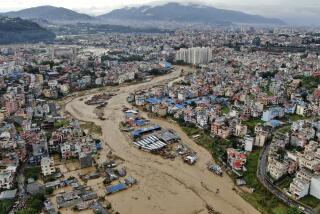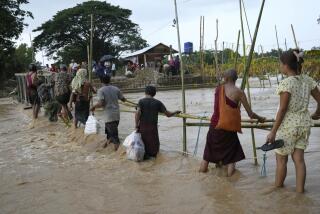Army Feeding Homeless in Bangladesh
- Share via
BAILTALI, Bangladesh — Barefoot women, among the millions of homeless in flooded Bangladesh, clambered from boats Monday onto the only strip of this village still above water and surrounded army officers who doled out food.
In the light rain, they pushed each other to get at the giant cooking pots. They stuffed fistfuls of cooked rice and lentils into their pots and bowls, or into the folds of their mud-stained saris.
Floods have submerged three-fourths of the country and claimed at least 406 lives this summer, according to official figures. More than 92,000 people are known to suffer from diarrhea and 5,715 more from dysentery, the Health Ministry said.
Taslimur Rahman, joint secretary of the Health Ministry, told reporters in Dhaka, the capital, that people get the diseases by drinking impure water, often the very floodwater that maroons them.
Officials say water purification tablets are being distributed, but residents of Bailtali, a village of 2,000 people 55 miles southwest of Dhaka, said they had not seen any.
“The water that is available to drink is the floodwater. We have no option but to drink it,” Injul Haq Majumder, a teacher, told reporters who arrived by helicopter.
Only two short strips of road, totaling about 500 yards, remained above water in Bailtali. One was covered with makeshift shelters of bamboo poles and palm thatch, and the other was bare of anything except the food kettles as two air force helicopters descended through the rain.
More than 100 small fishing boats bobbed beside the road in floodwaters that had engulfed power lines and left only the tips of poles and a few loops of wire visible.
People throughout Bangladesh are huddled on tiny outcroppings of muddy earth like those at Bailtali.
During a helicopter tour Monday of the countryside, the largest bit of land seen was about the size of a football field.
“Almost all the districts are like this. Don’t think this is the worst,” Information Minister Mahbubur Rahman told a dozen foreign journalists who accompanied him on the flight.
About 45 miles west of Dhaka at the confluence of the Jamuna and Ganges, mighty rivers even in non-flooding months, muddy brown water stretched for up to 25 miles, interrupted only by protruding treetops.
Entire villages had vanished. In some towns, people had pitched tents on the roofs of buildings that are high enough to be above water level, and taken their goats and chickens to safety with them.
Rahman said 50 of the country’s 64 districts and 25 million of its 110 million people have been “directly affected” by floods that began in June, then eased, but worsened again last week.
“It is a calamity,” he said. “It’s like a war situation, and then you have to reconstruct the country.”
Rahman said it was too early to put a cost on the damage and reconstruction, but he called the loss “colossal--homes, agriculture, communications, bridges, culverts, educational institutions, all damaged or washed away.”
More to Read
Sign up for Essential California
The most important California stories and recommendations in your inbox every morning.
You may occasionally receive promotional content from the Los Angeles Times.










